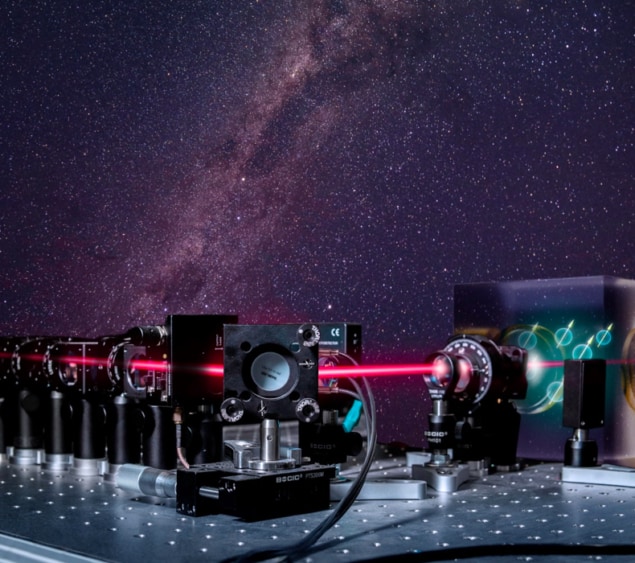Spin-based amplifier searches for axions
19 Sep 2022 Isabelle Dumé
Bridging the gap between previous laboratory searches and astrophysical observations. (Courtesy: X Peng)
A sensitive new way of detecting particle interactions in the laboratory has been used for the first time to search for axions, a hypothetical form of dark matter. Using a so-called spin-based amplifier, an international team of physicists succeeded in constraining the axion mass within the predicted “axion window” of 0.01 meV to 1 meV, thereby bridging the gap between previous laboratory searches and astrophysical observations.
Axions were first hypothesized in the 1970s as a way of explaining an outstanding puzzle in physics known as the charge-parity problem. According to theory, they would have been produced abundantly after the Big Bang, and should be both chargeless and much less massive than electrons, meaning that they would interact very weakly with matter and electromagnetic radiation. This makes them a popular candidate for dark matter, a mysterious substance that appears to make up most of the matter the universe and affects the gravitational properties of large objects such as galaxies.
Exotic dipole-dipole interaction
The new axion search method takes advantage of a further prediction about axion behaviour: when fermions (particles with half-integer spin) exchange axions, they should produce an exotic dipole-dipole interaction that could, in principle, be detected in the laboratory. In the latest study, a team led by Xinhua Peng of the University of Science and Technology of China, together with researchers led by Dmitry Budker from the Helmholtz Institute, Johannes Gutenberg University, Mainz, Germany, and UC Berkeley in the US, combined a large ensemble of polarized rubidium-87 (87Rb) atoms (a source of electron spins) with polarized xeon-129 (129Xe) nuclear spins to look for evidence of this interaction.
The nuclear spins act as an amplifier for weak pseudo-magnetic fields that could be generated by electrons exchanging axions, and experiments showed that this spin-based amplifier could enhance external magnetic fields by a factor of more than 40. “The axions could then be searched through measuring this field,” Peng explains. “To search for axions with masses within the axion window of 0.01 meV to 1 meV, we adjust the distance the 129Xe spin-based amplifier and the Rb spin source to the centimetre scale.”
The technique allowed the researchers to constrain the axion mass from 0.03 meV to 1 meV, which lies in the range predicted by several theories, including high-temperature lattice QCD, the Standard Model Axion Seesaw Higgs portal inflation (SMASH) model and axion string networks. “Until now, existing laboratory searches (for example, cavity experiments like ADMX) and astrophysical observations (for example, SN1987A, white dwarfs, and Globular Clusters) mostly searched for axions with masses outside this window (with the exception of the ORGAN experiment in Western Australia),” Peng tells Physics World. “Our result reaches into the axion-window parameter space, complementing existing astrophysical and laboratory studies on potential Standard-Model extensions.”
Improving experimental sensitivity
Peng says the technique might be further extended to search for a wide variety of hypothetical particles beyond the Standard Model of particle physics, such as Z’ bosons and dark photons. “With our technique, for example, we can search for a broad range of exotic interactions mediated by new particles, such as paraphoton-mediated interactions, whose corresponding search sensitivity should be many orders of magnitude better than existing constraints,” says Peng. “In addition, we can directly search for axion-like galactic dark matter that could couple with the nucleon, allowing for a sensitivity that surpasses previous laboratory limits by several orders of magnitude and even beyond those obtained by astrophysical observations.”READ MORE

In the meantime, the researchers, who detail their work in Physical Review Letters, say they will try to further improve the sensitivity of their technique to exotic interactions. For example, using an amplifier based on 3He electron spins or solid-state spin sources such as optically-pumped pentacene crystals could help achieve this, they say.

Isabelle Dumé is a contributing editor to Physics World
from physicsworld.com 2/11/2022

Δεν υπάρχουν σχόλια:
Δημοσίευση σχολίου